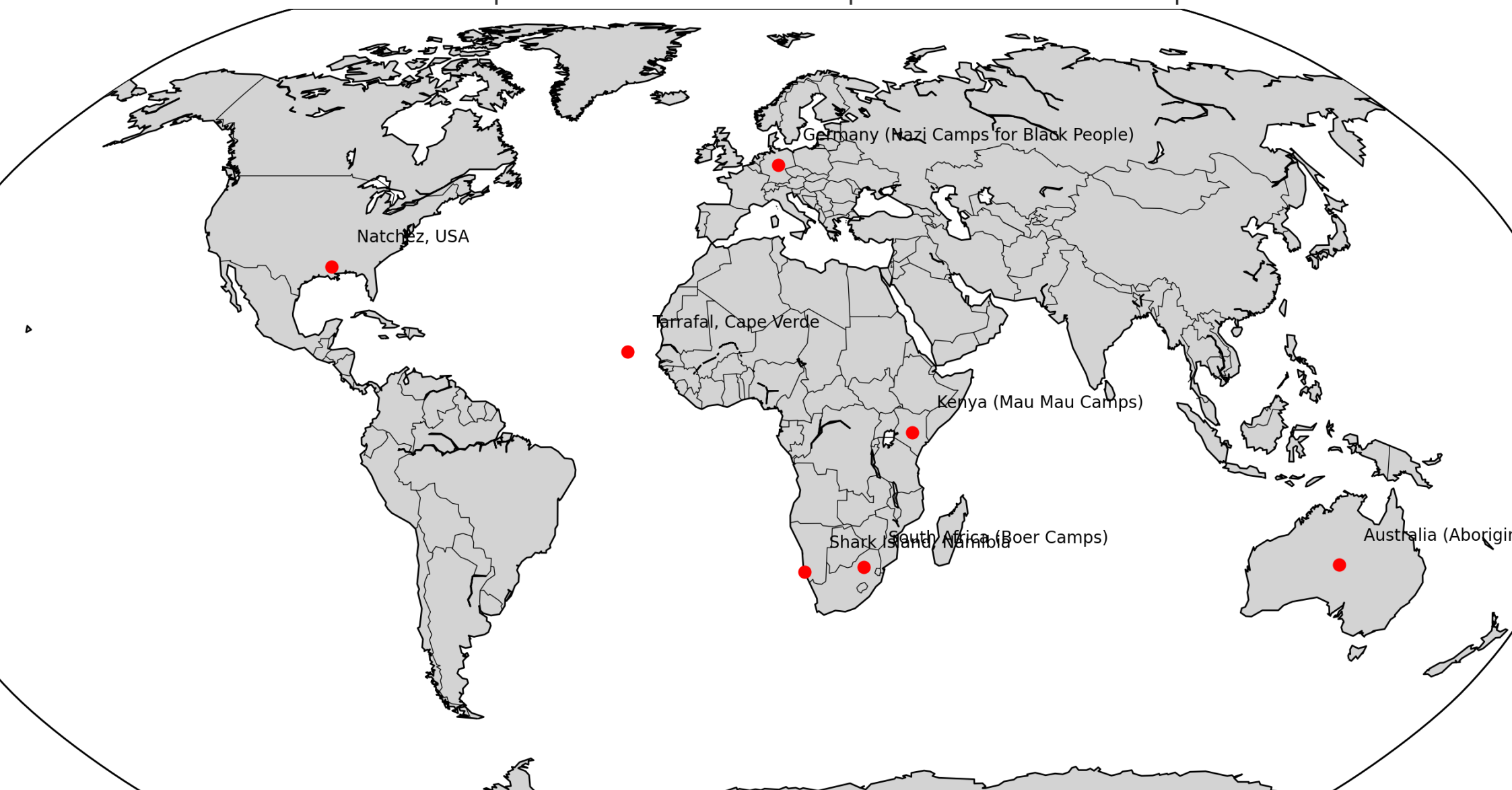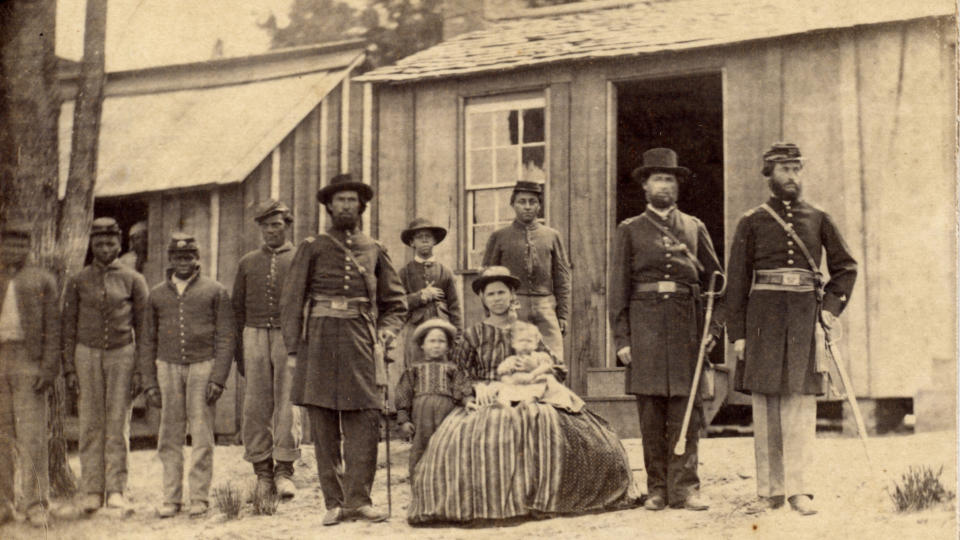From Mississippi to Namibia, from Australia to Kenya, a look back at seven concentration camps where history attempted to erase Black people. A memory to be reconstructed.
Concentration camps were not exclusive to the Third Reich. Before Auschwitz, during, and long after, millions of Black people were imprisoned, starved, and brutalized in camps built in the name of progress, order, or civilization. Yet, this truth remains absent from schoolbooks, pushed to the margins of global historiography.
In the style of an in-depth report, crossing geopolitics and memory, here are seven shameful examples of concentration camps designed for Black people, across the Northern and Southern Hemispheres. Seven places of suffering, racial strategy, and silence.
1. The “Devil’s Punchbowl” in Natchez (USA, 1863–1865): Chained Freedom

The name might sound whimsical if it didn’t refer to one of the first American concentration camps in the post-slavery era. In Natchez, Mississippi, in a natural basin called Devil’s Punchbowl, the Union Army—ironically the liberators of Southern slaves—confined over 20,000 newly freed African Americans in abominable conditions. Without access to clean water or sufficient food, these men, women, and children, deemed “human surplus,” died by the thousands. Sources point to an implicit will for “natural regulation” through famine and disease. Emancipation did not always rhyme with humanity.
2. The Aboriginal Camps in Australia (1909–1970): Legalized Extermination



White Australia built its identity on denying Aboriginal existence. With the Aborigines Protection Act of 1909, the country established a series of detention and forced labor camps, often disguised as “educational” institutions. Children were torn from their families—the future “Stolen Generation”—along with adults deemed “unfit” for civilization. Behind the barbed wire, a policy of ethnic erasure unfolded, through sterilization, exploitation, and isolation. Entire generations grew up in oblivion, sometimes until the end of the 20th century.
3. Black Camps During the Boer War (South Africa, 1899–1902): The Forgotten of British History
The British camps for Boers are well known. Forgotten are the even more numerous camps established for Black Africans. During the Anglo-Boer War, the British Empire set up “refugee camps” for displaced Black laborers following the scorched-earth policy. Officially “protected,” they were in fact forced into labor under near-slavery conditions. No medical care. Little food. No status. They dug trenches, fed the troops, cleaned the weapons of those who scorned their humanity. Around 115,000 Africans were interned; more than 14,000 died.
4. Shark Island, Namibia (1904–1908): Prototype of Industrial Genocide






Before Auschwitz, there was Shark Island. Off the coast of Lüderitz in Namibia, this German camp served as a testing ground for what the 20th century would later call genocide. After the Herero and Nama rebellion against German occupation, the Kaiser sent troops to annihilate them. The result: over 100,000 dead—deported, beaten, starved, subjected to medical experiments. Victims’ skulls were sent to Berlin to justify racial theories. Germany’s colonial history didn’t begin in Europe—it began in Africa.
5. Tarrafal, Cape Verde (1936–1974): Portugal’s Tropical Gulag




Behind Cape Verde’s sunny façade, the Tarrafal camp was one of Portuguese colonialism’s most brutal tools. Initially used against opponents of the Salazar regime, it became in the 1960s a prison for African independence fighters. Angolans, Bissau-Guineans, Cape Verdeans: all endured torture, forced labor, and Nazi-inspired experiments in near-total isolation. It was nicknamed “the camp of slow death.” The goal wasn’t just punishment—it was symbolic annihilation of those who dreamed of a free Africa.
6. Mau Mau Camps in Kenya (1952–1960): Rebellion and Repression




In Kenya, the Mau Mau uprising crystallized the fight for independence. The British response was extremely violent: more than 1.5 million Kenyans were interned in a network of detention camps. Gagged, beaten, subjected to systematic humiliation, thousands of prisoners died in general indifference. The most infamous was Hola, where 11 prisoners were beaten to death for refusing to work. It wasn’t until 2013 that the UK timidly acknowledged responsibility—after a long legal battle.
7. Black People During the Nazi Holocaust (1933–1945): The Invisible Victims of Extermination



Little is said about Black people in Nazi Germany, yet their fate was tragically aligned with that of other “subhumans,” according to Hitlerian ideology. Many Afro-Germans were forcibly sterilized, excluded from schools, banned from employment, and many were sent to concentration camps. The case of the children born to African soldiers and German mothers—the “children of shame”—is particularly telling: they were taken from their families, interned, or used in experiments. The Black Holocaust is a historical reality still little known.
Why Must We Talk About This?
In each of these examples, the creation of camps for Black people was not an accident of history. It was a political decision. A tool of racial control. An architecture of contempt. Talking about these camps is to refuse planned amnesia. It is to put back at the center those whom official history exiled to the margins.
The memory of these camps should not be an exercise in guilt, but a call to vigilance. Even today, Black populations are overrepresented in prisons, conflict zones, and refugee camps. This colonial continuum, sometimes invisible, demands moral and political reparations. To know history is also to refuse its repetition.
Writing Against Erasure
Claude Ribbe wrote that “the history of Black people is a counter-history.” The one that is not told. The one that disturbs. The one that challenges certainties. These seven shameful examples are not anecdotal: they are systemic. They sketch a cartography of modern oppression. But they also call for a cartography of memory. A memory that does not ask to be acknowledged—it demands to be passed on.
